#w.h. holmes
Text
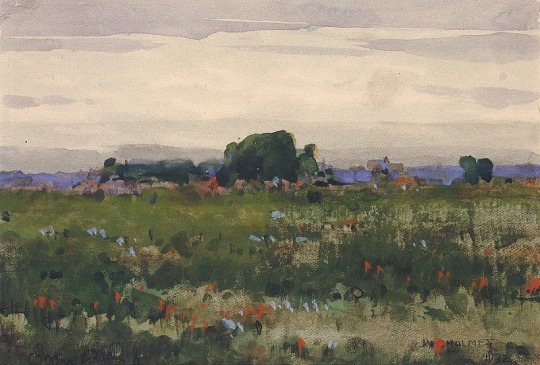
"Michigan" by W. H. Holmes.
Smithsonian American Art Museum, Gift of Dr. Anna Bartsch Dunne
1932
55 notes
·
View notes
Text
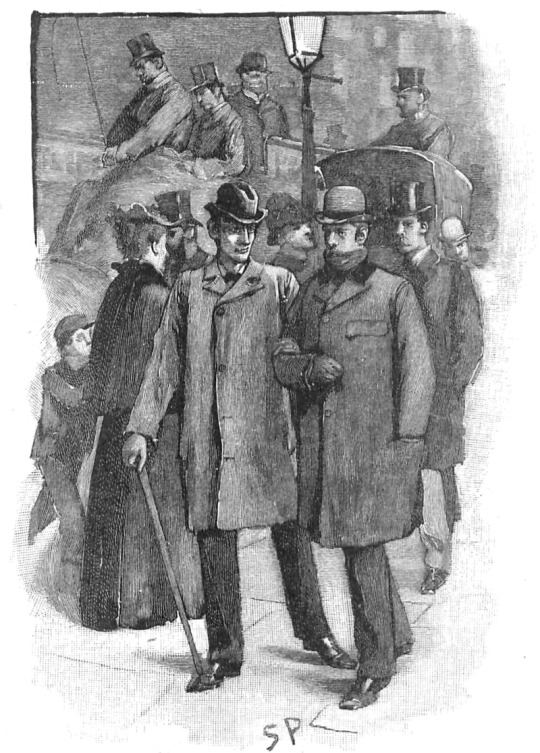
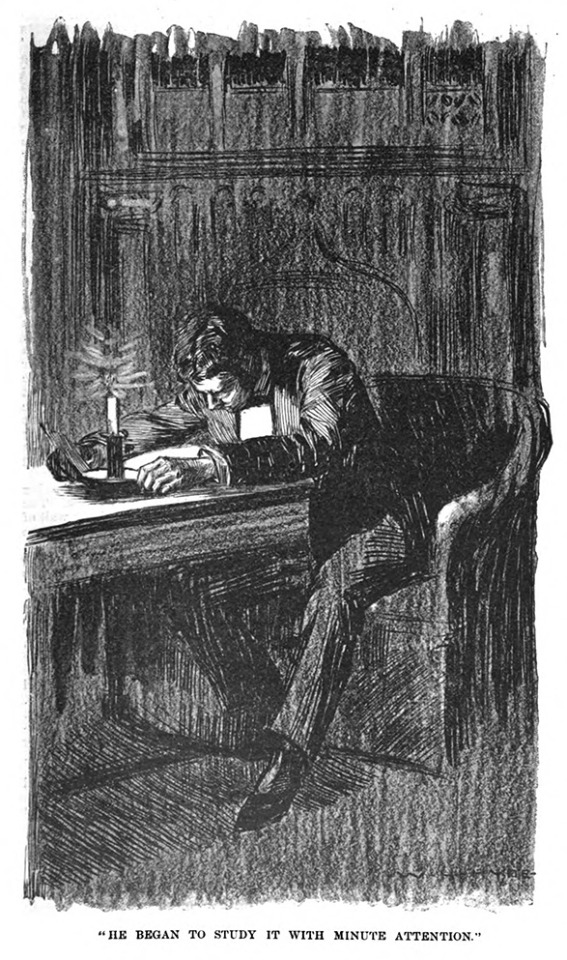
Left: “We strolled about together.”
Resident Patient, Sidney Paget, The Strand Aug/Sep 1893
Characters: Holmes, Watson
Right: “He began to study it with minute attention.”
Musgrave Ritual, W.H. Hyde, Harper's Weekly May 13th 1893
Characters: Brunton
13 notes
·
View notes
Text
youtube
Watch the 2024 American Climate Leadership Awards for High School Students now: https://youtu.be/5C-bb9PoRLc
The recording is now available on ecoAmerica's YouTube channel for viewers to be inspired by student climate leaders! Join Aishah-Nyeta Brown & Jerome Foster II and be inspired by student climate leaders as we recognize the High School Student finalists. Watch now to find out which student received the $25,000 grand prize and top recognition!
#ACLA24#ACLA24HighSchoolStudents#youtube#youtube video#climate leaders#climate solutions#climate action#climate and environment#climate#climate change#climate and health#climate blog#climate justice#climate news#weather and climate#environmental news#environment#environmental awareness#environment and health#environmental#environmental issues#environmental education#environmental justice#environmental protection#environmental health#high school students#high school#youth#youth of america#school
17K notes
·
View notes
Note
do you know any good quotes about ghosts or haunting?
“what do you know except for this haunt that i am?”
alice notley, from songs and stories of the ghouls
“we’re all of us haunted and haunting.”
chuck palahniuk, from lullaby
“may you not rest as long as i am living. you said i killed you — haunt me then.”
emily brontë, from wuthering heights
“dear ghosts, i’m sorry. who can understand? what we call history you call home.”
kathleen graber, from the eternal city: poems
“if haunting is anything, perhaps that’s what it is; time in the wrong place.”
jeanette winterson, from eight ghosts: the english heritage book of new ghost stories
“i’m a ghost that everyone can see.”
franz wright, from the beforelife: poems
“do not haunt my soul; i have done well forgetting you.”
jack kerouac, from on the road
“and ghosts must do again what gives them pain.”
w.h. auden, from the question
“it’s a ghost story. is it frightening? no, but it’s a bit sad.”
valeria luiselli, from faces in the crowd
“what is a ghost? something dead that seems to be alive. something dead that doesn’t know it’s dead.”
richard siken, from landscape with fruit rot and millipede
“& you know now, that anything alone is a haunting & any two things together is a terror.”
yves olade, from the miracle mille
“you are so vulnerably haunting; your eeriness is terrifyingly irresistible.”
franz kafka, letters to milena
“in one aspect, yes, i believe in ghosts, but we create them. we haunt ourselves.”
laurie halse anderson, wintergirls
“of all ghosts the ghosts of our old loves are the worst.”
sir arthur conan doyle, the memoirs of sherlock holmes
“nature is a haunted house⏤but art⏤is a house that tries to be haunted.”
emily dickinson, from the complete poems
“to live is to be haunted.”
philip k. dick, from flow my tears, the policeman said
“one need not be a chamber to be haunted, one need not be a house; the brain has corridors surpassing material place.”
emily dickinson, from the complete poems
#anon#asks#there are so many more quotes i could've used#probably missed out some really good ones as well#but here you go 🤍
49 notes
·
View notes
Text
POETRY LIST FROM BRIAN P: This list is made up of English language “lyric” poems by poets from what would become or is now the United States of America. They are in a random arrangement, not alphabetical or chronological. Allow them to play off each other in a variety of ways. Each poet is represented by only one poem.
May Swenson, The Centaur
Archibald MacLeish, Ars Poetica
Oliver Wendell Holmes, The Chambered Nautilus
Lucille Clifton, The Lost Baby Poem
Hart Crane, Voyages
H.D. Elegy and Choros
Wallace Stevens, Thirteen Ways of Looking at a Blackbird
Amy Lowell, The Garden by Moonlight
N. Scott Momaday, The Delight Song of Tsoai-talee
Francis Scott Key, Defense of Fort M’Henry
Langston Hughes, The Negro Speaks of Rivers
Adrienne Rich, Diving into the Wreck
Robert Hayden, Letter from Phyllis Wheatley
Bob Dylan, The Times They Are A-Changin’
James Dickey, Cherrylog Road
Chen Chen, I Invite My Parents to a Dinner Party
Joy Harjo, She Had Some Horses
Bonnie Larson Staiger, Grassland
Robert Frost, Stopping by Woods on a Snowy Evening
e.e. cummings, “anyone lived in a pretty how town”
Carl Sandburg, Chicago
James Russell Lowell, The Present Crisis
Ralph Waldo Emerson, The Snowstorm
Robert Lowell, For the Union Dead
Tommy Pico, I See the Fire that Burns Inside You
Emily Dickinson, “I started early – took my dog””
T.S. Eliot, The Hollow Men
Louise Gluck, The Wild Iris
Anonymous, Swing Low, Sweet Chariot
Gary Snyder, The Bath
Gwendolyn Brooks, We Real Cool
James Whitcomb Riley, L’il Orphant Annie
James Merrill, The Victor Dog
James Welch, Harlem, Montana: Just Off the Reservation
Frank O’Hara, Why I Am Not a Painter
John Ashbery, Self-Portrait in a Convex Mirror
William Carlos Williams, XXII, from Spring and All, The Red Wheelbarrow
Tupac Shakur, Changes
George Oppen, Five Poems about Poetry
Robert Bly, Driving to Town Late to Mail a Letter
Edwin Arlington Robinson, Mr. Flood’s Party
Richard Wright, Between the World and Me
John Greenleaf Whittier, Snowbound: A Winter’s Idyl
Phyllis Wheatley, His Excellency General Washington
Walt Whitman, When lilacs last by the dooryard bloom’d
Patricia Smith, The Stuff of Astounding: A Poem for Juneteenth
Edgar Allen Poe, The Raven
R.W. Wilson, Poemable
Marianne Moore, The Mind Is an Enchanting Thing
Julia Ward Howe, Battle Hymn of the Republic
Sylvia Plath, Tulips
Patricia Smith, The Stuff of Astounding: A Poem for Juneteenth
Thomas McGrath, A Coal Fire in Winter
Growing Concern Poetry Collective, Come to Me Open
Denise Lajimodiere, Dragonfly Dance
Edward Taylor, Housewifery
Jay Wright, Benjamin Banneker Sends His “Almanac” to Thomas Jefferson
Allen Ginsberg, Howl
David Solheim, In Moonlight
William Stafford, At the Bomb Testing Site
Ronald Johnson, Letters to Walt Whitman
Marge Piercy, To Be of Use
Mary Oliver, The Wild Geese
Wendell Berry, The Peace of Wild Things
W.H. Auden, Epitaph on a Tyrant
Richard Blanco, On Today
Timothy Murphy, Mortal Stakes
Lauryn Hill, Lost One
Don J. Lee/Haki Madhubuti, A Poem to Complement Other Poems
Louise Erdrich, The Strange People
Jericho Brown, Psalm 150
John Berryman, 11 Addresses to the Lord
Thomas Merton, Love Winter When the Plant Says Nothing
Anne Bradstreet, Before the Birth of One of Her Children
Frances E. W. Harper, Learning to Read
Randall Jarrell, Mail Call, and the children’s book “The Bat Poet”
Herman Melville, The Maldive Shark
Gertrude Stein, How She Bowed to Her Brother
Anne Sexton, In Celebration of My Uterus
Theodore Roethke, In a Dark Time
Edna St. Vincent Millay, “What lips my lips have kissed, and where and why”
Stephen Crane, A Man Saw a Ball of Gold
Robert Penn Warren, The Moonlight’s Dream
Paul Laurence Dunbar, The Colored Band
Henry David Thoreau, “The moon now rises to her absolute rule”
Emma Lazarus. The New Colossus
Sugar Hill Gang, Rapper’s Delight
Allen Tate, Ode to the Confederate Dead
Muriel Rukeyser, Ballad of Orange and Grape
Elizabeth Bishop, Sestina, “September rain falls on the house”
Judy Grahn, The Common Woman Poems (complete)
Lawrence Ferlinghetti, I Am Waiting
May Sarton, The Gift of Thyme
George Moses Horton, On Liberty and Slavery
Ezra Pound, The River-Merchant’s Wife: A Letter
Robinson Jeffers, Hurt Hawks
James Weldon Johnson, The Creation
Sherman Alexie, Sonnet, with Pride
Kenneth Koch, In Love With You
Jupiter Hammon, An Address to Miss Phillis Wheatley
A.R. Ammons, The Brook Has Worked Out the Prominence of a Bend
Anonymous, Go Down, Moses
Yusef Komunyakaa. Facing It
W.S. Merwin, After the Alphabets
Richard Wilbur, A Baroque Wall-Fountain in the Villa Sciarra
Henry Wadsworth Longfellow, The Day Is Done
Natalie Diaz, My Brother at 3 AM
Maya Angelou, On the Pulse of Morning
Raymond Roseliep, The Morning Glory
Rita Dove, Dawn Revisted
4 notes
·
View notes
Text
Read Book A Body of Work: An Anthology of Poetry and Medicine -- Corinna Wagner
A Body of Work: An Anthology of Poetry and Medicine - Corinna Wagner
READ & DOWNLOAD Corinna Wagner book A Body of Work: An Anthology of Poetry and Medicine in PDF, EPub, Mobi, Kindle online. Free book, AudioBook, Reender Book A Body of Work: An Anthology of Poetry and Medicine by Corinna Wagner full book,full ebook full Download.

Read / Download A Body of Work: An Anthology of Poetry and Medicine
DESCRIPTION BOOK : A Body of Work includes poems by writers from the dawn of Enlightenment to the 21st Century and explores changing attitudes to medicine, health and the body. The book is divided into eight thematic sections, each of which includes a chronological range of poetry and excerpts of important historical and contextual medical writing. The sections are:Body as machine Nerves, mind, and brain Consuming Illness, disease, and disability Treatment Hospitals, practitioners, and professionals Sex, evolution, and reproduction Ageing and dyingIncludes work by such poets as: Dannie Abse, Maya Angelou, Simon Armitage, Margaret Atwood, W.H. Auden, Elizabeth Bishop, John Burnside, Raymond Carver, Lucille Clifton, S. T. Coleridge, Erasmus Darwin, Emily Dickinson, John Donne, Mark Doty, T.S. Eliot, Paul Farley, Ann Finch, Allen Ginsberg, Robert Graves, Thom Gunn, Seamus Heaney, Oliver Wendell Holmes, Ted Hughes, Rudyard Kipling, Philip Larkin, Robert Lowell, Lady Mary Wortley Montagu, Paul Muldoon,
DETAIL BOOK :
Author : Corinna Wagner
Pages : 560 pages
Publisher : Bloomsbury Academic
Language :
ISBN-10 : 1472513290
ISBN-13 : 9781472513298
Supporting format: PDF, EPUB, Kindle, Audio, MOBI, HTML, RTF, TXT, etc.
Supporting : PC, Android, Apple, Ipad, Iphone, etc.
================*================
Tag the PDF
- A Body of Work: An Anthology of Poetry and Medicine by Corinna Wagner Ebook PDF
- A Body of Work: An Anthology of Poetry and Medicine by Corinna Wagner PDF Download
- A Body of Work: An Anthology of Poetry and Medicine by Corinna Wagner EPUB
- A Body of Work: An Anthology of Poetry and Medicine by Corinna Wagner EBOOK
- A Body of Work: An Anthology of Poetry and Medicine by Corinna Wagner PDF Online
- A Body of Work: An Anthology of Poetry and Medicine by Corinna Wagner E-BOOK Online
- A Body of Work: An Anthology of Poetry and Medicine by Corinna Wagner PDF Free
- A Body of Work: An Anthology of Poetry and Medicine by Corinna Wagner ebook library
- A Body of Work: An Anthology of Poetry and Medicine by Corinna Wagner pdf document
- A Body of Work: An Anthology of Poetry and Medicine by Corinna Wagner pdf reader
- A Body of Work: An Anthology of Poetry and Medicine by Corinna Wagner ebook creator
- A Body of Work: An Anthology of Poetry and Medicine by Corinna Wagner ebook deals
- A Body of Work: An Anthology of Poetry and Medicine by Corinna Wagner ebook kindle
- Ebook PDF A Body of Work: An Anthology of Poetry and Medicine by Corinna Wagner
- PDF Download A Body of Work: An Anthology of Poetry and Medicine by Corinna Wagner
- EPUB A Body of Work: An Anthology of Poetry and Medicine by Corinna Wagner
- EBOOK A Body of Work: An Anthology of Poetry and Medicine by Corinna Wagner
- PDF Online A Body of Work: An Anthology of Poetry and Medicine by Corinna Wagner
- E-BOOK Online A Body of Work: An Anthology of Poetry and Medicine by Corinna Wagner
- PDF Free A Body of Work: An Anthology of Poetry and Medicine by Corinna Wagner
- ebook library A Body of Work: An Anthology of Poetry and Medicine by Corinna Wagner
- pdf document A Body of Work: An Anthology of Poetry and Medicine by Corinna Wagner
- pdf reader A Body of Work: An Anthology of Poetry and Medicine by Corinna Wagner
- ebook creator A Body of Work: An Anthology of Poetry and Medicine by Corinna Wagner
- ebook deals A Body of Work: An Anthology of Poetry and Medicine by Corinna Wagner
- ebook kindle A Body of Work: An Anthology of Poetry and Medicine by Corinna Wagner
0 notes
Photo

they look fine
#mod holmes#w.h art#w.h post#nintendo#Mr l#Mr. l#Dimentio#late night doobles#super paper Mario#SPM#paper mario series#xp art
168 notes
·
View notes
Text
youtube
Watch the American Climate Leadership Awards 2024 now: https://youtu.be/bWiW4Rp8vF0?feature=shared
The American Climate Leadership Awards 2024 broadcast recording is now available on ecoAmerica's YouTube channel for viewers to be inspired by active climate leaders. Watch to find out which finalist received the $50,000 grand prize! Hosted by Vanessa Hauc and featuring Bill McKibben and Katharine Hayhoe!
#ACLA24#ACLA24Leaders#youtube#youtube video#climate leaders#climate solutions#climate action#climate and environment#climate#climate change#climate and health#climate blog#climate justice#climate news#weather and climate#environmental news#environment#environmental awareness#environment and health#environmental#environmental issues#environmental justice#environment protection#environmental health#Youtube
16K notes
·
View notes
Text

“Stone statue, Nicaragua” , image by W.H. Holmes
From: “Pottery of Costa Rica and Nicaragua”, 1926.
2 notes
·
View notes
Text
Owned TBR-list of Doom
Or; I own too many books and I have too little time to get to them all.
I want to say that I’ll entirely pull my reads this year off my own shelves, but it’s rather unlikely to actually happen. Mood reader and all that.
Shamelessly stealing @lettersfromthelighthouse ‘s formatting - bold is started, strikethrough is finished. Imagine that the titles are italicised; tumblr refuses to copy formatting done in another file. I hope I shall keep updating this post, but I am notoriously forgetful, so there’s that.
Sorted into categories, but no alphabetical order under the cut:
Non-fiction, historic:
The Illustrated Red Baron, Peter Kilduff
Crossroads, Reizen door de Middeleeuwen, David Abulafia (red.)
Five Miles High & Forty Below, Bill Williams
Vergeten volkeren, Philip Matyszak
The Discovery of Middle Earth, Graham Robb
Nobel Streven, Frits van Oostrom
The Darkening Age, Catherine Nixey
The Histories, Herodotus
Where Poppies Blow, John Lewis-Stempel
Een paleis voor de doden, Herman Clerinx
The Edge of the World, Michael Pye
The Silk Roads, Peter Frankopan
Danubia, Simon Winder
De uitvinding van de natuur, Andrea Wulf
Vriend Over Vijand, Peter van Damme
Non-fiction, historic equine:
Dressage, Sylvia Loch
The Royal Horse of Europe, Sylvia Loch
The Warhorse 1250-1600, Ann Hyland
The Medieval Horse and its Equipment, John Clark
The Horse in the Ancient World, Ann Hyland
The Horse in the Middle Ages, Ann Hyland
The Medieval Warhorse, From Byzantium to the Crusades, Ann Hyland
Non-fiction, equine training manuals:
True Horsemanship Through Feel, Bill Dorrance & Leslie Desmond
Grondwerk met paarden, Inge Teblick
Pferde Gymnastizieren mit dem Clicker, Viviane Theby
Gymnasium of the Horse, Steinbrecht
Basic Training of the Young Horse, Ingrid & Reiner Klimke
The Scales of Training Workbook, Claire Lilley
Non-fiction, miscellaneous:
Stolen World, Jennie Erin Smith
Dier, bovendier, Frank Westerman
The Old Ways, A Journey On Foot, Robert Macfarlane
Entangled Life, Merlin Sheldrake
The Travels, Marco Polo
J.R.R. Tolkien Artist & Illustrator, Hammond & Scull
Zout, Vet, Zuur, Hitte, Samin Nosrat
Fiction, ‘classics’:
Moby-Dick, Herman Melville
Don Quixote, Cervantes
The Master & Margarita, Mikhail Bulgakov
Maurice, E.M. Forster
The Complete Sherlock Holmes, Sir Arthur Conan Doyle
Gone With the Wind, Margaret Mitchell
The Picture of Dorian Grey, Oscar Wilde
Mrs. Dalloway, Virginia Woolf
Wuthering Heights, Emily Bronte
Lord of the Flies, William Golding
Jane Eyre, Charlotte Bronte
Metamorphosen, Ovidius
Fiction, ‘classic sci-fi’:
Frankenstein, Mary Shelley
The Great Science-Fiction, H.G. Wells
Treasure Island, R.L. Stevenson
Dr. Jekyll and Mr. Hyde, R.L. Stevenson
Het geheimzinnige eiland, Jules Verne
Michael Strogoff, Jules Verne
Fiction, fantasy:
The Two Towers, J.R.R. Tolkien
The Return of the King, J.R.R. Tolkien
The Worm Ouroboros, E.R. Eddison
Het helse paradijs, Thea Beckmann
Kinderen van moeder aarde, Thea Beckmann
Piranesi, Susanna Clarke
Jonathan Strange & Mr. Norrell, Susanna Clarke
Black Leopard, Red Wolf, Marlon James
Beren and Luthien, J.R.R. Tolkien
The Fall of Gondolin, J.R.R. Tolkien
The Children’s Book, A.S. Byatt
Rivers of London, Ben Aaronovitch
The Story of Kullervo, J.R.R. Tolkien
Fiction, sci-fi:
Hyperion, Dan Simmons
The Three-Body Problem, Liu Cixin
The Testaments, Margaret Atwood
Caliban’s War, James S.A. Corey
Fiction, historic:
Lincoln in the Bardo, George Saunders
The Essex Serpent, Sarah Perry
Butcher’s Crossing, Jon Williams
The Last English King, Julian Rathbone
Parade’s End, Ford Maddox Ford
Heer Belisarius, Robert Graves
De naam van de roos, Umberto Eco
Fiction, anthologies:
Trigger Warning, Neil Gaiman
The Weird Tales of William Hope Hodgson, W.H. Hodgson
The Call of Cthulhu, H.P. Lovecraft
Norse Mythology, Neil Gaiman
Tales Before Tolkien, Douglas A. Anderson (ed.)
Fiction, Poetry:
Shelley, Shelley (too lazy to check for the editor, it’s not on the cover)
The War Poems of Wilfred Owen, Wilfred Owen
Fiction, Miscellaneous:
Overstory, Richard Powers
Frankissstein, Jeanette Winterson
How to be Both, Ali Smith
De Hills, Matias Faldbraken
#owned-tbr#tbr#tbr of doom#morgoth-level doom#*cries in too many books started but never finished*#my reading#my books
5 notes
·
View notes
Text
Seldom seen—archaeological textiles in the eastern United States
In my very first “Introduction to Anthropology” class, the professor, a cultural anthropologist, tried to steer us away from archaeology by telling us it was a childish pursuit for those who liked to play in the mud and hunt for treasure. That sounded like it was right up my alley. I ended up spending my summers and an internship term working in Plymouth, Massachusetts, doing historical archaeology. In addition, I also spent a lot of time in the collections of the college anthropology museum, found that I especially loved working with textiles and basketry, and eventually learned to weave both.
Working in the eastern United States, it’s hard to find archaeological textiles; the very world is against it. Acid soils and a temperate climate create conditions where little organic material survives to be studied, except in the rare instances of charred material or pieces in contact with copper, or still rarer, textiles deposited in dry caves. Even then the evidence is usually fragile and fragmentary.
What eastern archaeologists find is a lot of pottery, and luckily for us, much of it has been impressed with cordage or fabric. As part of the pottery making process, clay coils were consolidated by being beaten with a wooden paddle, a tool frequently wrapped with cordage or fabric. This technique may have initially developed to create decoration, but the resulting roughened surface also made for a better grip, and the increased surface area caused pots to heat quicker in cooking.
Archaeologists study the long-vanished textiles by making durable impressions of pottery surfaces with modeling clay or dental impression material. The information revealed through the thorough study of such impressions is not limited to the determination of just what type of cord or textile was used in making the original object.
The making of pottery impressions to look at textiles was first published by the pioneering archaeologist, W.H. Holmes, in “Prehistoric Textile Art of the Eastern United States”. Holmes started his scientific career as an illustrator, and included schematic drawings of the textile structures in his article.

Textile illustrations by Holmes.
When I worked at what is now the Florida Museum of Natural History, I got interested in the earliest pottery found in Florida, from what is known as the Orange culture. Dating from about 1500 BCE, these distinctive pieces were thick and very simply decorated. Their most interesting feature, at least to me, was that the clay pot bottoms had been pounded flat on matting, and the applied force made deep impressions. At least three different techniques were used, with variations and patterns within each, including several different matting materials.

Mat impressions from flat-bottomed pots, Tick Island, Volusia County, FL.
In one instance, a thick pot sherd had a smooth top surface, but a deep dent in the bottom; evidence the potter hadn’t removed a small pebble that was under the mat before the pot making.
Many studies have been done since W.H. Holmes, looking at such things as direction of the twist in cordage—a majority of right-handed or left-handed twist could indicate a culture-wide preference. Similar twist types in neighboring geographic areas might indicate related cultural or kin groups, while different twist types such areas could indicate a cultural boundary. The type of material used [soft fiber, hard rods, flat cane-like splints] may indicate cultural preference, or perhaps the materials available in the immediate environment.
One study by Dr Penelope Drooker, Mississippian Village Textiles at Wickliffe, introduced me both to some incredible textile impressions in pottery and the information that can be gleaned from them. Drooker’s work also analyzed and illustrated some textiles preserved in dry caves of eastern Tennessee, part of the Cherokee people’s ancestral lands. Among the materials she studied were skirts and bags from the Cliffty Creek Cave, artifacts now housed at the Smithsonian Institution. Working with the Museum of the Cherokee Indian in Cherokee, NC, I was able to re-introduce members of the tribe to one of the oldest weaving techniques of their ancestors. A few tribal members have visited the Smithsonian to photograph Cliffty Creek Cave pieces [as have I], and are now making skirts for use in festivals and pageants. Several are making decorated bags for their own use, and for sale.

Kara Martin McKinney wearing reproduction of Cliffty Creek Cave skirt, and reproduction woman’s feather cape. Image Credit: Scott McKie, reporter for the Cherokee One Feather weekly newspaper in Cherokee, NC.
One of the great things about textiles or pottery is that you could spend your entire life studying them, and still not learn all that these materials embody --techniques, cultural traditions, and art, all rolled into one. My grandfather, who kept his faculties up to his death in his mid-90s, said, “The day you stop learning is the day you start to die.” I try to live by that.
Deborah Harding is the Collection Manager of the Section of Anthropology at Carnegie Museum of Natural History. Museum employees are encouraged to blog about their unique experiences and knowledge gained from working at the museum.
References and further reading:
Drooker, Penelope Ballard 1992 Mississippian village textiles at Wickliffe, University of Alabama Press: Tuscaloosa and London
Holmes, W. H. 1896 “Prehistoric Textile Art of the Eastern United States” Thirteenth Annual Report of the Bureau of American Ethnology to the Secretary of the Smithsonian Institution 1891–1892, Government Printing Office Washington, pages 3–46.
Milanich, Jerald T. and Charles H. Fairbanks 1980 Florida Archaeology Academic Press: New York
Petersen, James B [editor] 1996 A most indispensable art: native fiber industries from Eastern North America, University of Tennessee Press: Knoxville
http://www.phmc.state.pa.us/portal/communities/archaeology/native-american/early-middle-woodland-period.html
68 notes
·
View notes
Text

Reginald Leigh Dugmore (20 November 1891 – 16 June 1967), better known as Reginald Denny, achieved success both as an English stage, film and television actor, and as an aviator and UAV pioneer. He was also once amateur boxing champion of Great Britain.
Born as Reginald Leigh Dugmore on 20 November 1891 in Richmond, Surrey, England, he came from a theatrical family; his father was actor and opera singer W.H. Denny. In 1899, Master Reginald Denny began his stage career in A Royal Family and starred in several London productions from age seven to twelve. At sixteen, he ran away from a boarding school and trained as a pugilist with Sir Harry Preston at the National Sporting Club; he also appeared in several British stage productions touring the music halls of England of The Merry Widow. In 1911, he went to the United States to appear in Henry B. Harris's stage production of The Quaker Girl, then joined the Bandmann Opera Company as a baritone touring India and the Far East India where he performed for Krishna Raja Wadiyar IV.
Although he worked in "flickers" during 1911 and 1912, Reginald officially began his film career in 1915 with the World Film Company and made films both in the United States and Britain until the 1960s. Among the numerous stage productions in which he starred, Reginald appeared in John Barrymore's 1920 Broadway production of Richard III; the two actors became friends and starred in several films together including Sherlock Holmes (1922), Hamlet (1933), Romeo and Juliet (1936), and Paramount's Bulldog Drummond series (1937-1938).
Denny was a well-known actor in silent films, and with the advent of talkies he became a character actor. He played the lead role in a number of his earlier films, generally as a comedic Englishman in such works as Private Lives (1931) and later had reasonably steady work as a supporting actor in dozens of films, including The Little Minister (1934) with Katharine Hepburn, Anna Karenina (1935) with Greta Garbo, Alfred Hitchcock's Rebecca (1940) and the Frank Sinatra crime caper film Assault on a Queen (1966). He made frequent appearances in television during the 1950s and 1960s. His last role was in Batman (1966) as Commodore Schmidlapp. In 2020, Kino Lorber released 4K restorations on DVD and Blu-ray of three of Denny's silent comedies: The Reckless Age, Skinner’s Dress Suit, and What Happened to Jones? in The Reginald Denny Collection.
Denny served as an observer/gunner in the First World War in the new wartime Royal Air Force.
In the 1920s he performed as a stunt pilot with the 13 Black Cats and loaned his WWI Sopwith Snipe biplane to Howard Hughes for use in Hell's Angels (1927). In the early 1930s, Denny became interested in free-flight model airplanes. In 1934, he and oil tycoon Max Whittier's son, Paul Whittier, formed Reginald Denny Industries and opened a model plane shop, which became a chain known as the Reginald Denny Hobby Shop, now California Hobby Distributors.
He designed his "Dennyplane" with its signature model engine "Dennymite," developed by engineer Walter Righter, in addition to the "Denny Jr." which child actors would enter in model plane competitions at Mines Field, which later became Los Angeles International Airport. In 1935, Denny began developing his remote controlled "radioplane" for military use. In 1939, he and his partners won the first military United States Army Air Corps contract for their radio-controlled target drone, the Radioplane OQ-2. In July 1940, they formed the Radioplane Company and manufactured nearly fifteen thousand drones for the US Army during the Second World War. The company was purchased by Northrop in 1952.
Denny had a great deal in common with Robert Loraine, an older actor / Airman. They had been in a West End production together in 1902 in London,[5] they were both veterans of the RFC (and its successor, the Royal Air Force) and were both still flying and making films in Hollywood in the 1930s. It is possible that Denny's interest in radio controlled aircraft was influenced by his old RFC colleagues and the British unmanned aircraft developments.
Denny married actress Irene Hilda Haismann on 28 January 1913 in Calcutta, both were with the Bandmann Opera Company. They had one daughter but were divorced in 1928. Denny married actress Isabelle "Betsy Lee" Stiefel in 1928 and they had three children.
Denny died on 16 June 1967 at the age of 75, after suffering a stroke whilst visiting his sister in his home town of Richmond in England. His body was buried at Forest Lawn-Hollywood Hills Cemetery in Los Angeles, California. His wife Isabelle survived him until 1996, living to age 89.
#reginald denny#silent era#silent hollywood#silent movie stars#classic movies#classic hollywood#classic movie stars#golden age of hollywood#1910s movies#1920s hollywood#1930s hollywood#1940s hollywood#1950s hollywood#1960s hollywood
15 notes
·
View notes
Photo



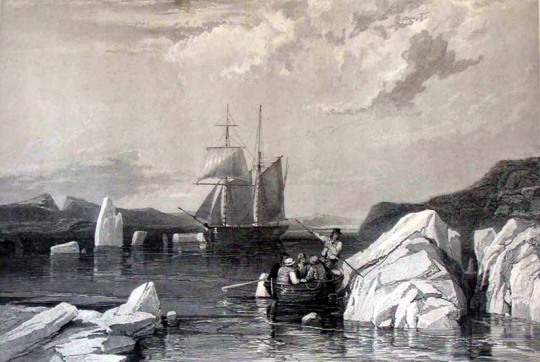



James Clark Ross’s ships
HMS Isabella (midshipman, 1818), HMS Hecla (midshipman, 1819-20; lieutenant, 1827), HMS Fury (midshipman, 1821-23; lieutenant, 1824-25), Victory (second-in-command, 1829-32), HMS Victory (supernumerary commander, 1833-34), HMS Erebus (captain, 1839-43), HMS Enterprise (captain, 1848-49)
Not pictured: HMS Briseis (first-class volunteer, midshipman, 1812-14), HMS Acteon (midshipman, 1814-15), HMS Driver (midshipman, 1815-17), HMS Cove (captain, 1835-36)
Artist information and a few notes below:
I wasn’t able to find images of Briseis, Acteon, Driver, or Cove. Though the ship plans for Driver are here and here if anyone’s interested.
Although Ross’s name was on HMS Victory’s books from 1833-34 to give him the necessary service time to be promoted to post-captain, he was on leave the entire time to assist with his uncle’s narrative of the 1829-33 Victory expedition.
Images:
James Whittle and Richard Holmes Laurie. Portrait of the Vessels on the Polar Exploration of 1818. 1818. Colored etching. National Maritime Museum, Greenwich, London. Detail. (x)
George Lyon. “The Last Appearance of the Sun for 42 Days”, in The Private Journal of Captain G.F. Lyon of HMS Hecla During the Recent Voyage of Discovery Under Captain Parry. London: John Murray, 1824.
Henry Parkyns Hoppner. Situation of H.M. Ship Fury August 25th 1825. 1826. Tinted engraving. National Maritime Museum, Greenwich, London. (x)
John Ross. “The Victory Under Sail for the Last Time”, in Narrative of a Second Journey in Search of a North-West Passage and of a Residence in the Arctic Regions During the Years 1829, 1830, 1831, 1832, 1833. London: A.W. Webster, 1835.
Edward William Cooke, H.M.S. Victory First Rate 104 Guns. Portsmouth Harbour. The Flagship of the Late Lord Nelson. On board of which he was killed off Trafalgar Oct 21st 1805. c. 1828-30. Colored etching. National Maritime Museum, Greenwich, London. (x)
Richard Brydges Beechey, HMS ‘Erebus’ Passing Through the Chain of Bergs, 1842. 1860. Oil on canvas. National Maritime Museum, Greenwich, London. (x)
W.H. Brown. The Devil’s Thumb, Ships Boring and Warping in the Pack. 1850. (x)
Sources:
O’Byrne, William Richard. A Naval Biographical Dictionary. London: John Murray, 1849.
House of Commons. “Report from Select Committee on the Expedition to the Arctic Seas”. London: s.n., 1834.
Ross, M.J. Polar Pioneers: John Ross and James Clark Ross. Montreal: McGill-Queen’s University Press, 1994.
128 notes
·
View notes
Text
Works Cited

“Alexander Graham Bell.” Wikipedia, Wikimedia Foundation, 27 April, 2020, https://en.wikipedia.org/wiki/Alexander_Graham_Bell.
“The Angels Take Manhattan.” Doctor Who, written by Steven Moffat, directed by Nick Hurran, season 7, episode 5, BBC One, 29 September 2012.
Anghelides, Peter. The Seismologist’s Story. Big Finish Productions, Short Trips: Repercussions, story 4, August 2004.
“Asylum of the Daleks.” Doctor Who, written by Steven Moffat, directed by Nick Hurran, season 7, episode 1, BBC One, 12 September 2012.
“Before the Flood.” Doctor Who, written by Toby Whithouse, directed by Daniel O’Hara, season 9, episode 4, BBC One, 10 October 2015.
“The Bells of Saint John.” Doctor Who, written by Steven Moffat, directed by Colm McMarthy, season 7, episode 6, BBC One, 30 March 2013.
Bringer of Darkness. By Warwick Gray, illustrated by Martin Geraghty, Marvel Comics, DWMS Summer 1993, June 1993.
“The Caretaker.” Doctor Who, written by Gareth Roberts and Steven Moffat, directed by Paul Murphy, season 8, episode 6, BBC One, 27 September 2014.
“The Chase.” Doctor Who, written by Terry Nation, directed by Richard Martin, season 2, serial 8, BBC1, 22 May-26 June 1965.
“Clara and the TARDIS.” Doctor Who Home Video, written by Steven Moffat, directed by Jamie Stone, BBC, 24 September 2013. Retrieved from
https://www.youtube.com/watch?v=-8I9z6Y4mBY&t=2s
“The Claws of Axos.” Doctor Who, written by Bob Baker and Dave Martin, directed by Michael Ferguson, season 8, serial 3, BBC1, 13 March-3 April 1971.
Cole, Stephen. The Monsters Inside. BBC Books, book 2, 19 May 2005.
Cornell, Paul. Timewyrm: Revelation. Virgin Books, book 4, 5 December 1991.
The Dalek Book. By David Whitaker and Terry Nation, Souvenir Press, BBC tv, 30 June 1964.
“The Dalek Invasion of Earth.” Doctor Who, written by Terry Nation, directed by Richard Martin, season 2, serial 2, BBC1, 21 November-26 December 1964.
“Dark Water.” Doctor Who, written by Steven Moffat, directed by Rachel Talalay, season 8, episode 11, BBC One, 1 November 2014.
“Death Comes to Time.” Doctor Who Webcast, written by Colin Meek, directed by Dan Freedman, part 5, BBCI-1, 13 July-3 May 2002. Retrieved from https://www.youtube.com/watch?v=YGC8ZGNRR98&t=8s
“Death in Heaven.” Doctor Who, written by Steven Moffat, directed by Rachel Talalay, season 8, episode 12, BBC One, 8 November 2014.
Deceit. By Peter Darvill-Evans, cover by Luis Rey, Virgin Books, book 13, 15 April 1993.
“Deep Breath.” Doctor Who, written by Steven Moffat, directed by Ben Wheatley, season 8, episode 1, BBC One, 23 August 2014.
“The Doctor’s Daughter.” Doctor Who, written by Stephen Greenhorn, directed by Alice Troughton, season 4, episode 6, BBC One, 10 May 2008.
“The Edge of Destruction.” Doctor Who, written by David Whitaker, directed by Richard Martin and Frank Cox, season 1, serial 3, BBC tv, 8-15 February 1964.
“The Empty Child.” Doctor Who, written by Steven Moffat, directed by James Hawes, season 1, episode 9, BBC One, 21 May 2005.
“The End of Time: Part Two.” Doctor Who, written by Russell T Davies and Steven Moffat, directed by Euros Lyn, season 4, special 7, BBC One, 1 January 2010.
“Extremis.” Doctor Who, written by Steven Moffat, directed by Daniel Nettheim, season 10, episode 6, BBC One, 20 May 2017.
“Face the Raven.” Doctor Who, written by Sarah Dollard, directed by Justin Molotnikov, season 9, episode 10, BBC One, 21 November 2015.
“Flatline.” Doctor Who, written by Jamie Mathieson, directed by Douglas Mackinnon, season 8, episode 9, BBC One, 18 October 2014.
“For Four Years More.” The New York World (03 March, 1893), volume 33, issue number 11,518: 2 pages. Print. Retrieved from
https://newspaperarchive.com/new-york-world-mar-03-1893-p-1/
“The Girl Who Died.” Doctor Who, written by Jamie Mathieson and Steven Moffat, directed by Ed Bazalgette, season 9, episode 5, BBC One, 17 October 2015.
Goss, James. Dismemberment. BBC Books, The Missy Chronicles, 22 February 2018.
“Heaven Sent.” Doctor Who, written by Steven Moffat, directed by Rachel Talalay, season 9, episode 11, BBC One, 28 November 2015.
“Hell Bent.” Doctor Who, written by Steven Moffat, directed by Rachel Talalay, season 9, episode 12, BBC One, 5 December 2015.
“The Husbands of River Song.” Doctor Who, written by Steven Moffat, directed by Douglas Mackinnon, season 9, special 17, BBC One, 25 December 2015.
“Into the Dalek.” Doctor Who, written by Phil Ford and Steven Moffat, directed by Ben Wheatley, season 8, episode 2, BBC One, 30 August 2014.
“Journey to the Center of the TARDIS.” Doctor Who, written by Steve Thompson, directed by Mat King, season 7, episode 10, BBC One, 27 April 2013.
Kludt, Amanda. “Remembering Delmonico’s, New York’s Original Restaurant.” NYEater.com, 29 June 2011, https://ny.eater.com/2011/6/29/6673317/remembering-delmonicos-new-yorks-original-restaurant.
“Last of the Time Lords.” Doctor Who, written by Russell T Davies, directed by Colin Teague and Graeme Harper, season 3, episode 13, BBC One, 30 June 2007.
Laundro-Room of Doom. By Nick Abadzis, illustrated by Eleonora Carlini, The Fountains of Forever, Titan Comics, 2 May 2015.
“Let’s Kill Hitler.” Doctor Who, written by Steven Moffat, directed by Richard Senior, season 6, episode 8, BBC One, 27 August 2011.
“The Lie of the Land.” Doctor Who, written by Toby Whithouse, directed by Wayne Yip, season 10, episode 8, BBC One, 3 June 2017.
“Listen.” Doctor Who, written by Steven Moffat, directed by Douglas MacKinnon, season 8, episode 4, BBC One, 14 September 2014.
Martin, Philip. Vengeance on Varos. Target Books, W.H. Allen, book 106, 16 June 1988.
Rayner, Jacqueline. The Last Dodo. BBC Books, book 14, 19 April 2007.
Mortimore, Jim and Lane, Andy. Lucifer Rising. Virgin Books, book 14, 20 May 1993.
“Mummy on the Orient Express.” Doctor Who, written by Jamie Mathieson, directed by Paul Wilmshurst, season 8, episode 8, BBC One, 11 October 2014.
“The Name of the Doctor.” Doctor Who, written by Steven Moffat, directed by Saul Metzstein, season 7, special 13, BBC One, 18 May 2013.
“Nekromanteia.” Doctor Who Audio, written by Austen Atkinson, directed by John Ainsworth, number 41, Big Finish Productions, February 2003.
“The Parting of the Ways.” Doctor Who, written by Russell T Davies, directed by Joe Ahearne, season 1, episode 13, BBC One, 18 June 2005.
“Planet of the Ood.” Doctor Who, written by Keith Temple, directed by Graeme Harper, season 4, episode 3, BBC One, 19 April 2008.
Rayner, Jacqueline. Original Sin. BBC Books, The Missy Chronicles, 22 February 2018.
“Revenge of the Cyberman.” Doctor Who, written by Gerry Davis, directed by Michael Briant, season 12, serial 5, BBC1, 19 April-10 May 1975.
Richards, Justin. Silhouette. BBC Books, book 55, 11 September 2014.
Shark Bait. By Bill Mevin, Polystyle Publications, Ltd, TV Comic, issue 728-731, 27 November-18 December 1965.
“Silver the Trouble.” The New York World (03 March, 1893), volume 33, issue number 11,518: 1 page. Print. Retrieved from
https://newspaperarchive.com/new-york-world-mar-03-1893-p-1/
“The Snowmen.” Doctor Who, written by Steven Moffat, directed by Saul Metzstein, season 7, special 11, BBC One, 25 December 2012.
“The Sontaran Stratagem.” Doctor Who, written by Helen Raynor, directed by Douglas Mackinnon, season 4, episode 4, BBC One, 26 April 2008.
“The Sound of Drums.” Doctor Who, written by Russell T Davies, directed by Colin Teague, season 3, episode 12, BBC One, 23 June 2007.
“The Sun Makers.” Doctor Who, written by Robert Holmes, directed by Pennant Roberts, season 15, serial 4, BBC1, 26 November-17 December 1977.
“Sword of Orion.” Doctor Who Audio, written and directed by Nicholas Briggs, number 17, Big Finish Productions, 26 February 2001.
“Terminus.” Doctor Who, written by Steve Gallagher, directed by Mary Ridge, season 20, serial 4, BBC1, 15-23 February 1983.
Time Bomb. By Jamie Delano, illustrated by John Ridgway, Marvel Comics, Doctor Who Magazine, issue 114-116, 12 June-14 August 1986.
“Time Heist.” Doctor Who, written by Steve Thompson and Steven Moffat, directed by Douglas Mackinnon, season 8, episode 5, BBC One, 20 September 2014.
“The Time of the Doctor.” Doctor Who, written by Steven Moffat, directed by Jamie Payne, season 7, episode 7, BBC One, 25 December 2013.
Tucker, Mike. Diamond Dogs. BBC Books, book 61, 20 April 2017.
“Twice Upon A Time.” Doctor Who, written by Steven Moffat, directed by Kit Pedler and Gerry Davis and Chris Chibnall, season 10, special 19, BBC One, 25 December 2017.
“Under the Lake.” Doctor Who, written by Toby Whithouse, directed by Daniel O’Hara, season 9, episode 3, BBC One, 3 October 2015.
“Vengeance on Varos.” Doctor Who, written by Philip Martin, directed by Ron Jones, season 22, serial 2, BBC1, 19-26 January 1985.
“The Witch’s Familiar.” Doctor Who, written by Steven Moffat, directed by Hettie MacDonald, season 9, episode 2, BBC One, 26 September 2015.
“The Woman Who Lived.” Doctor Who, written by Catherine Tregenna, directed by Ed Bazalgette, season 9, episode 6, BBC One, 24 October 2015.
“World Enough and Time.” Doctor Who, written by Steven Moffat, directed by Rachel Talalay, season 10, episode 11, BBC One, 24 June 2017.
“The Zygon Inversion.” Doctor Who, written by Peter Harness and Steven Moffat, directed by Daniel Nettheim, season 9, episode 8, BBC One, 7 November 2015.
2 notes
·
View notes
Text
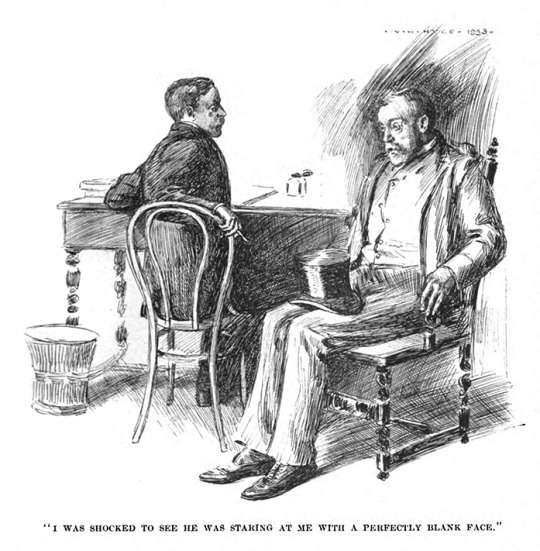
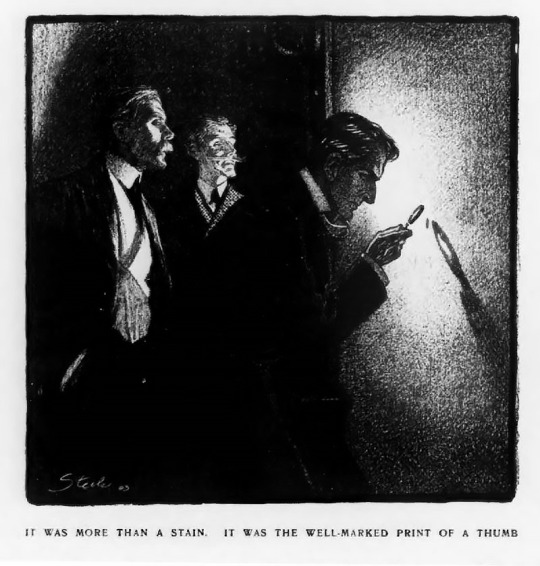

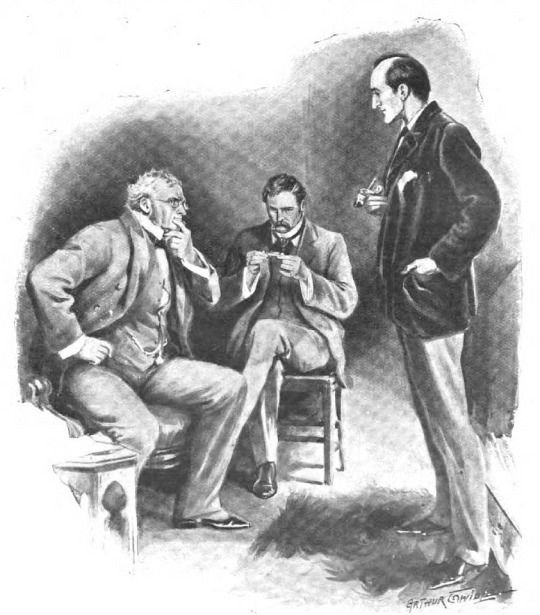
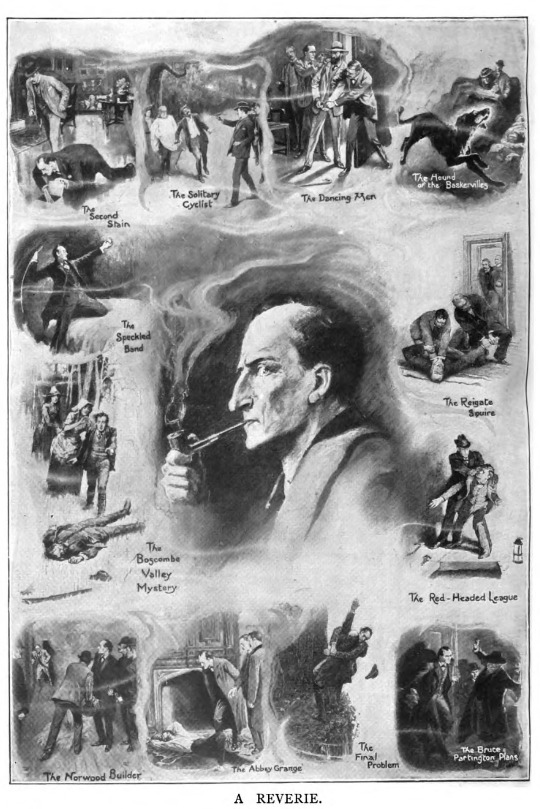

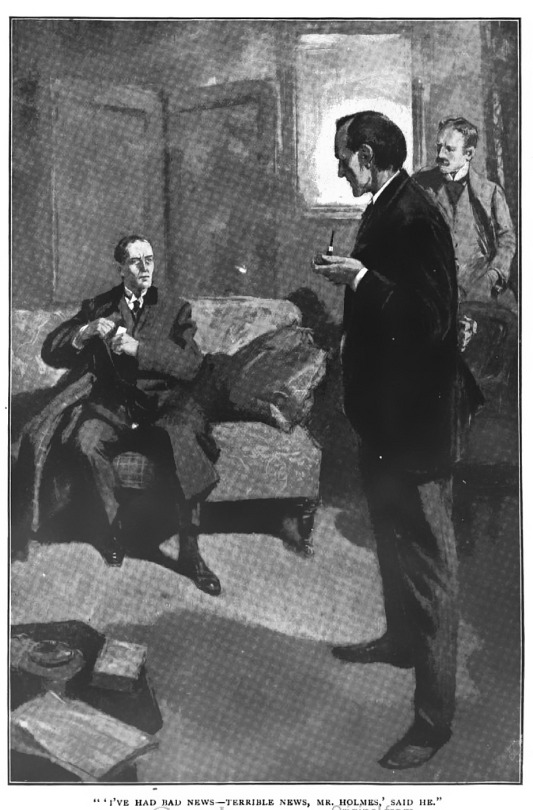


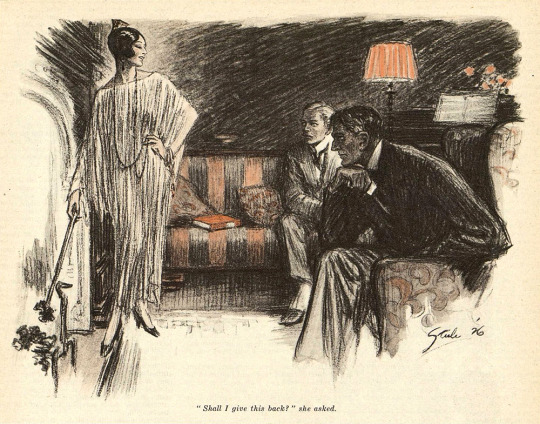
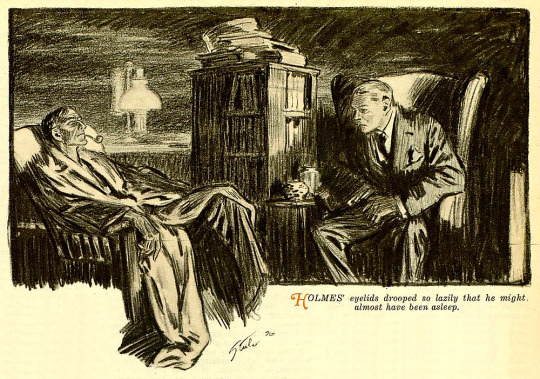
Vote for your favourite, the top 9 will proceed in the bracket. Since theyre all different shapes and sizes, make sure to click into the full views!
Paget Eliminations / Other Artist Eliminations
Full captions and details for each illustration below the cut:
"I was shocked to see he was staring at me with a perfectly blank face." W.H. Hyde, Resident Patient (Harper’s Weekly)
Characters: Percy Trevelyan, 'Russian Nobleman'
"It was more than a stain. It was the well-marked print of a thumb." FD Steele, Norwood Builder (Collier’s)
Characters: Watson, Lestrade, Holmes
"Miles McLaren." FD Steele, Three Students (Collier’s)
Characters: Miles McLaren
"But I have been running around and making inquires before I came to you." Arthur Twidle, Wisteria Lodge (The Strand)
Characters: John Scott Eccles, Watson, Holmes
"A reverie" Joseph Simpson, Red Circle (The Strand)
Characters: Holmes &c.
"Leaning forward in the cab, Holmes listened intently to McDonald's short sketch of the problem which awaited us in Sussex." Frank Wiles, Valley of Fear (The Strand)
Characters: Watson, Holmes, MacDonald
"I've had bad news - Terrible news, Mr. Holmes." Frank Wiles, Valley of Fear (The Strand)
Characters: MacDonald, Holmes, Watson
"She poured her whole wild fury out in burning and horrible worlds - I put my hands to my ears and rushed away." Alfred Gilbert, Thor Bridge (The Strand)
Characters: Maria Gibson, Grace Dunbar
"Mrs. Ferguson kneeling by the cot gave no answer to her husband's reproaches save to gaze at him with a wild despairing look in her eyes." WT Benda, Sussex Vampire (Hearst’s International)
Characters: Baby Ferguson, Mrs Ferguson
"Shall I give this back?" she asked." FD Steele, Three Gables (Liberty)
Characters: Isadora Klein, Watson, Holmes
"Holmes' eyelids drooped so lazily that he might almost have been asleep." FD Steele, Retired Colourman (Liberty)
Characters: Holmes, Watson
20 notes
·
View notes
Text
2019
Hello,
Missed me?
No longer a monthly mailer – just another end of year round up.
On reflection, perhaps I’ve played it a bit safe this year, but I didn’t feel there was as much great music out there as in previous years.
Yes, I too use Google, so I have listened to all the end of year Best Of lists online, and so those artists not included just didn’t resonate with me this year.
I maintain ‘bad guy’ off Billie Eilish’s record sounds like a Super Mario bonus level (probably in a spooky dungeon)… which I suppose isn’t a bad thing. And I love Lana, but I just didn’t think the latest record was all that. And the same was true of Angel Olsen, Nick Cave, Kanye, Hot Chip… but don’t get me started on Bon Iver: avant-garde “Kum ba yah” at best (sorry Rob).
But then that’s part of the joy of music, variety and differing opinions… so please share yours! What have I overlooked? What should be revisited? Where in the depths of streaming services is that killer track from 2019?
For now, here is my list of songs, somewhat crowbarred into the monthly format (as mentioned, this email was once called New Music Monthly Mailer with five tracks a month, and surely we need some level of constancy and accountability this year).
Enjoy, or not – but please do share your own choice picks.
Merry Christmas.
R x
NEW MUSIC 2019
JANUARY
Sharon Van Etten - Seventeen
Just go and watch her performance from Glastonbury: https://youtu.be/BM6jn891seU
Seriously, from 2:45, just fucking brilliant.
J.S. Ondara - Saying Goodbye
Lovely acoustic number and a great voice that evokes Tracy Chapman.
Basekou Kouyate, Ngoni ba - Kanto kelena (feat. Habib Koite)
Malian ngoni master returns to acoustic roots.
Delicate Steve - Selfie of a Man
Synthy silly catchy instrumental pop-rock.
Steve Gunn - Vagabond
Guitar troubadour telling stories of solitude with unostentatious guitar tones.
FEBRUARY
Mara Balls - Ikävä ikävää
Driving Finnish Doom-lite.
Julie Jacklin - Body
A narrative masterclass, sombre and brooding, but also simmering and pulsating.
Strand of Oaks - Weird Ways
Big widescreen rock, which builds into a gorgeous swirl of sound, with Timothy on fine yet reflective form, backed by the band of My Morning Jacket.
Crows - Hang Me High
Long awaited debut from Idles approved band, loud fuzz Mary Chain / Dom Keller vibes.
Kel Assouf - Fransa
Desert blues, with all the best Tuareg styling, but added beefy production.
MARCH
Nick Waterhouse - Man Leaves Town
Mr Waterhouse and band well in the pocket.
Dave - Streatham
Heavy beats and piano lines soundtrack story of growing up in SW16.
Karen O, Danger Mouse - Turn The Light
Danger Mouse brings the gentle disco grooves underneath Karen’s swooning vocals.
Small Feet - The Lake
Down tempo reverb and echoes float throughout this woozy directionless jam.
The Brian Jonestown Massacre - Tombes Oubliées
BJM do what BJM do best... in French.
APRIL
The Comet Is Coming - Summon The Fire
How can you not move to this?!
W.H. Lung - Empty Room
Great new band (c.f. mailer 2017!), and as I already included ‘Inspiration!’ this is my second favourite cut from a top album.
Josefin Öhrn + The Liberation - Feel The Sun
Another great artist (championed back in 2016 I think you’ll find), spectral psych grooves.
Weyes Blood - Mirror Forever
Great opening line, there’s a coldness but also strangely comforting.
Foxygen - News
Now a lot people had fallen off the Foxygen wagon recently, including me, but this is catchy melody filled vibes, with a completely unexpected stonking T-Rex style groove that kicks in around the 3:30 minute mark
MAY
Lizzo – Juice
Speaking of good vibes… I mean, again, just go watch the Glastonbury set: https://youtu.be/R9CTs1NsZRI.
Tyler, The Creator - EARFQUAKE
Production values: A*, chances of not leaving… C-
The 100 Knights Orchestra - Soul Fugue
Celebrating Daptone Records 100th RPM single, this special features every horn player the label has ever worked with, and it is glorious.
Death and Vanilla - A Flaw In The Iris
Devendra Banhart vibes to begin, fazing in Mazzy Star style reverb and guitars.
Desert Sands - Are You There
The best psychedelic space rock released… ever!
JUNE
Rose City Band - Fog of Love
Warm tones and laid back ambles, which has producer Ripley Johnson’s stamp all over it.
Madonnatron - Goodnight Little Empire
Disco ditty extraordinaire.
The Black Keys - Lo/Hi
Have you heard of ZZ Top? You have?
The Amazons - Doubt It
Future rock heroes get dark.
Fat White Family, Parrot and Cocker Too - Feet - Parrot and Cocker Too Remix
Gone for the remix version of this great track: what isn’t improved by added shakers and throbbing techno?
JULY
Michael Kiwanuka, Tom Misch - Money (with Tom Misch)
The first of two Kiwanuka tracks in this list, but this was a standalone single, and has all the bubbly bass groove it was impossible not to include.
Drake, Rick Ross - Money In The Grave (Drake ft. Rock Ross)
Speaking of money… bounce!
DOPE LEMON - Salt & Pepper
Weird keys give way to J.J. Cale style guitar noodles, whilst Angus heaps on the druggy references adding to the meandering stoned atmosphere.
The Quiet Temple, Moon Duo - The Last Opium Den On Earth (Moon Duo Remix)
Speaking of druggy… 12 minutes of acid psych jazz in the last opium den on earth.
Nev Cottee - Hello Stranger
Cinematic and pastoral, but also searing
AUGUST
Palace - Running Wild
Top class indie pop nugget with great simple guitar solo to end.
Kandodo 3 - Everything Green's Gone
This definitely isn’t for everyone: think Nine Inch Nails soundtracks at their most impenetrable, if you can make it two thirds of the way through this 13 minute wig out, there are some great slide guitars.
Clairo – Bags
Breakout bedroom pop with one of the hookiest melodies all year.
Mini Mansions - Works Every Time
Behind the beat smooth grooves.
Death Hawks - Whisper
Squelchy over produced 80s style pop bananas,
SEPTEMBER
Native Harrow - Can't Go On Like This
Inevitable Laurel Canyon / Joni Mitchell comparisons on this retro analogue sound ballad.
Ty Segall - The Arms
Ty does a rare acoustic number, and even throws in a rather tasteful mandolin line.
Pixx - Funsize
Synth bleeps and beats disguise a Radiohead-esque creeping guitar line.
Sleater-Kinney - The Future Is Here
Love the motorik dirge vibes here, underpin lovely vocal lines and melodies which remind us: the future is here, and we can’t go back.
Marika Hackman - i'm not where you are
Great pop hooks and guitar lines.
OCTOBER
Dylan LeBlanc - Renegade
I’m a big fan of LeBlanc and his retro stylings, and this track is super lilting 80s driving rock.
TOOL - Pneuma
I struggled to get TOOL for a while, but this record and this track in particular is fucking phenomenal.
Lightning Dust - Devoted To
Amber Webber and Joshua Wells’ solo project (previously of Black Mountain), conjure spectral dreamscapes.
Sturgill Simpson - Remember To Breathe
Sturgill goes electronic rawk – and Tomoyasu Hotei wants his production back.
Michael Kiwanuka - Hero
Here he is again, with the standout track from a truly brilliant album.
NOVEMBER
Kelsey Waldon - White Noise, White Lines
Kentucky country groove rock.
WIVES - Waving Past Nirvana
Churning fuzz rock underpins laconic loose vocals, cool.
Pumarosa - I See You
Tense synth verses give way to soaring superb choruses.
Jaako Eine Kalevi - Dissolution
Finnish synth pop architect doing a very good Matthew Dear impersonation.
Warmduscher - Midnight Dipper
“The offspring of a match made in hell between Fat White Family and Paranoid London” – full-on sleazy glam.
DECEMBER
Pond - Don't Look at the Sun (Or You'll Go Blind) – Live
My favourite track the band perform live, now finally available on streaming.
Staff Benda Bilili - Jamais de la vie
The famous Congolese street band return with tight uplifting grooves.
Khruangbin, Leon Bridges - Texas Sun
Sit back, open a cold one, and enjoy (when summer comes back around).
Jimmy "Duck" Holmes - Catfish Blues
Mississippi delta blues from the 72 year old Holmes, produced by Dan Auerbach.
Mikal Cronin - Show Me
Long-time Ty Segall collaborator serves up some Tom Petty-esque soft rock.
#new music#best of 2019#2019 music#psych rock#alternative music#rock music#best rock#top music#shoegaze#2019#j.s. ondara#mikal cronin#leon bridges#fat white family#jimmy duck holmes#khruangbin#warmduscher#wives#kelsey waldon#staff benda bililli#sturgill simpson#michael kiwanuka#kiwanuka#pumarosa#jaako eine kalevi#delicate steve#sharon van etten#lizzo#native harrow#pixx
2 notes
·
View notes
Text
John's bisexuality [further proof]
I'm not sure if this has already been addressed in some meta works whatsoever but I couldn't find anything so here we go.
I recently saw @finalproblem 's post with the original birth certificate of John Watson (as in the props one from the show) and it occurred to me that he shares his birthday with the death date of our beloved Shakespeare. The 23rd of April.
It's interesting to note that the ACD canon birthday isn't the same though.

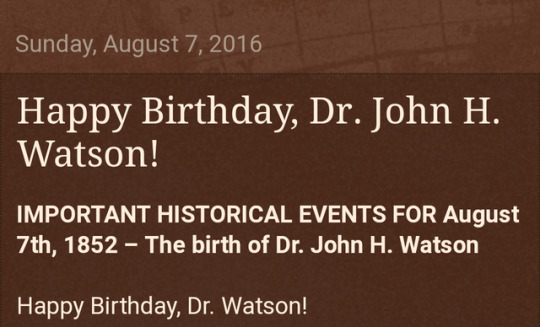

Whether it's the 7th July or August (sources differ regarding the exact date) neither of these options are even close to bbc John's b-day.
But why? Why change his birthday? They did after all take Sherlock's canon birthdate. The change must've been deliberate and important then. So it's got something to do with Shakespeare. Shakespeare whose sexuality has been thoroughly discussed. Shakespeare who many suspect was bisexual. Shakespeare who married a woman and still addressed no less than 126 poem to men, a very specific man actually, someone with the initials of W.H
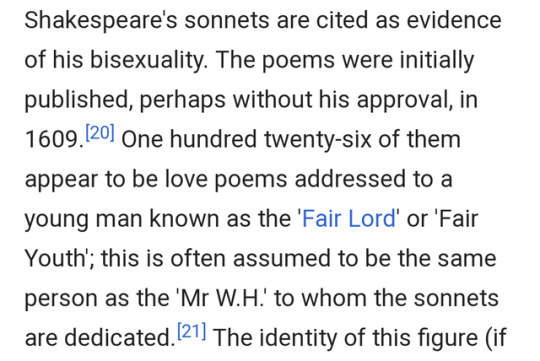
Mr. W. H.
Huh. That reminds me of someone... Ahhh right!
William Sherlock Scott Holmes
Considering the fact that Mofftiss already referenced Shakespeare through John's famous counting of Irene's texts (57, one famous, particularly gay poem) it's probably safe to say that this is intentional mirroring at its finest.
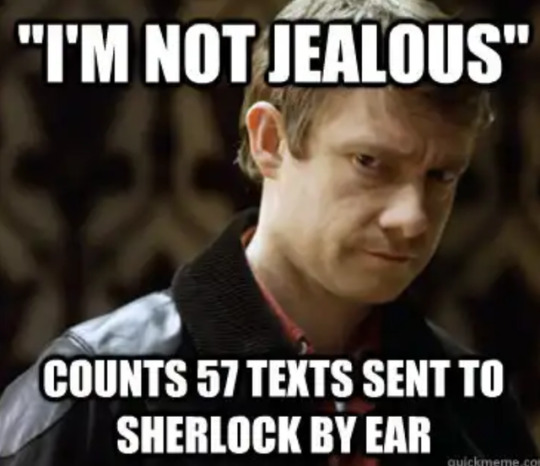
Also THIS:
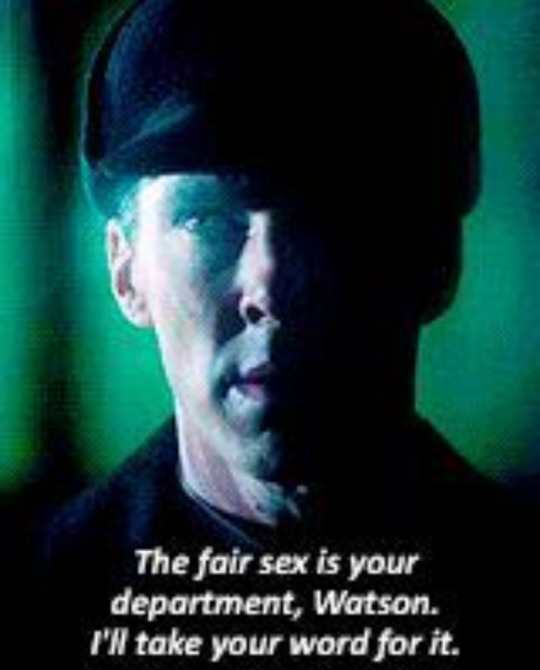
when W.H is also typically called 'Fair Youth' or 'Fair Lord'
Mofftiss is enjoying this little game of theirs/ours a bit too much considering they literally put references wherever they can get away with it.
#johnlock#sherlock#sherlockbbc#sherlock holmes#john watson#sherlock and john#sherlock meta#mini meta#tjlc#clueing for looks till season 5 comes#and beyond of course#tjlc meta#tjlc is endgame#tjlc is real#john is bi#john is bisexual#bisexual
110 notes
·
View notes
Text
Metafictional Monday: Tristan und Isolde
I promise that this is not merely a veiled plea for more fic authors to include Tristan in their Holmesian works.
This blog has already covered some of Holmes’ love for grand opera, so now it’s time for a deep dive into Wagnerian music drama. Tristan und Isolde is not explicitly referenced in canon (according to this database, at least), but REDC tells us that Holmes was a Wagnerite:
‘Well, Watson, you have one more specimen of the tragic and grotesque to add to your collection. By the way, it is not eight o'clock, and a Wagner night at Covent Garden! If we hurry, we might be in time for the second act.'
I have, I realize, long headcanoned this Wagner night as a night for Tristan und Isolde, because of all Wagner’s works, it’s Tristan where you really want to be in time for the second act. It’s also an opera that’s often spoken of, in hushed and reverent tones, as changing music. (It’s a reputation widespread enough to have found its way into this charming article on electromagnetic physics, written by a kindred spirit of Holmes’, it would seem.) It broke the rules of operatic structure. It broke the rules of musical harmony. It is reliably taught in music history courses, because you can’t not teach Tristan. It opens, you see, with an unresolved chord. The entire overture leads the audience to expect its resolution; it seems to be leading inevitably up to it... and instead, the curtain rises on a sailor singing about his distant lover, lamenting their separation.
That chord remains unresolved for all four hours of the opera... until the end, the ecstatic end, when Isolde sings that impossible resolution into being, as she proclaims her oneness with Tristan and with the universe.
youtube
Oh yes. This is arguably the most erotic of operas; it is also an opera in which sex never takes place, in part because the two lovers will be satisfied with nothing less than complete spiritual oneness. “Doch dieses Wörtlein: und!” laments Isolde, in Act II (”But this little word, and!”) It’s too much of a division. What they are seeking is a physical and spiritual consummation in which, fully, it is both or none... and, following the Schopenhauer-influenced logic of the opera, it can only truly be at once both and none, through a final union that is also dissolution.
For 1865 opera audiences -- used to orchestras representing physical love in all sorts of ways -- this was just beyond the pale. It was experienced as a physical and spiritual crisis; it was written about as a moral scandal. (Wagner infamously wrote it inspired by his own adulterous affair, which didn’t help matters.) Even now, 150 years on, when everyone entering the opera house knows what they’re getting into, it is a unique experience. The sheer physical and mental tension of waiting for that resolution (for four hours) is not to be underestimated. In a good performance, the emotional tension is excruciating; in a great performance, it redefines the limits of the bearable. Did I mention that the great central love duet of the second act, in which the chord never resolves, lasts for 25 or 40 minutes, depending on whether you define it as lasting from the entrance of the tenor or the moment where the lovers beg night to descend on them? They beg, in this central moment of their love, to be released from the world, to be set free, to be allowed to forget everything outside their love, in order that they might truly live.
Ahem. And this -- this -- is what is referenced in at least two canon adaptations, to my knowledge. In Bert Coules’ justly famous radio series, it’s invoked in connection with the Cornish landscape that is such an important element in the opera, by Merrison’s Holmes in “The Devil’s Foot.” The episode has opened with Holmes and Watson’s mingled, panting breath; they’re half-drowned. When they go to Cornwall for Holmes’ recovery, he grumbles that dying would have been indistinguishable from survival... thus invoking one of the opera’s key themes, the dissolution of the boundary between death and life. Watson, bless his heart, protests that the landscape is romantic; Holmes responds by quoting part of that love duet: “so might we die, in order to [live] undivided, without awaking, without fear, namelessly surrounded by love.” The episode translates the words less exactly, condensing the text of the opera: “So let us die and never part, together for the rest of time. No more waking, no more feeling -- nameless, endless, loving, sharing, existing only in each other, wrapped in love and death and darkness.”
In the second Tristan-invoking adaptation, Granada’s “Red Circle,” the final sequence is inaugurated by Brett’s bitter pronouncement: “The law is what we live with, inspector; justice is sometimes harder to achieve.” Watson, as ever more optimistic, comments that “English justice looked kindly” on the young couple involved in the death of the piece’s villain. But Holmes -- Holmes goes to the opera. The stagehand he knew there was Italian, as were the other protagonists of the drama. It doesn’t make intrinsic sense to have this opera, this pair of lovers invoked, though there is the canon reference to the Wagner night. And this is indeed an ideal opera to invoke if what you’re talking about is impossible desire, and you want a pair of lovers for whom gender is immaterial (W.H. Auden once famously remarked that Tristan and Isolde reminded him of a pair of lesbians.) So we get Holmes, standing motionless and trembling behind Watson at the opera, weeping, anguished, as Isolde sings about a love only she can see as possible, as that chord remains unresolved, blending instead into a version of the show’s own music.
Tristan und Isolde did not premiere in London until 1882. Earlier reports in the English press had deplored it as “ugly” and having “no melody.” A cartoon responded to the premiere by representing the editor of a musical periodical as disheveled in his distress, entirely nonplussed by The Tristan Chord. (Yes, the chord has a name. It’s that special.) A later review, more measured, refused explicitly to pass judgment on the work’s “absolute and relative merit,” but did pronounce that “the unity of feeling and expression, the continuity of unremitting passion here displayed, are probably unprecedented in the history of music.” It’s a judgment in which many subsequent critics have concurred.
#metafictional monday#opera#tristan und isolde#granada holmes#brett holmes#Bert Coules#merrison holmes#Clive Merrison#Jeremy Brett#music#TCHAIKOVSKY IS NOT AN ISOLATED CASE#is this blog's music tag apparently
22 notes
·
View notes